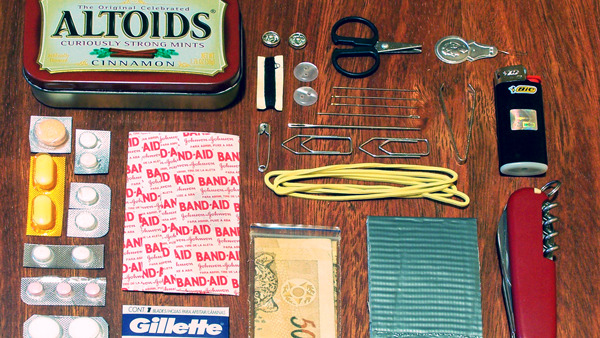Because of size, you really have to economize an Altoids Tin Survival Kit.
Once you do, however, you will be shocked how much stuff you can fit into one!
Shelter: Instead, focus on the basic ability to create some shelter. A small wire saw will help you trim tree limbs to size and a small amount of nylon (stronger than natural materials) cordage or fishing line can help you tie those limbs together.
Duct tape can be handy here too. Pull 18 inches or so off the roll and fold it up as thinly as possible. When it comes time to use it, tear it into thin strips, doing that will make a limited amount stretch much further.
Water: You'll need some sort of container and the ability to purify dirty water. Two unlubricated, plain condoms can each hold a gallon of water, while taking up very little space in your tin. Leave them in their wrapper to protect them.
A few water purification tablets can be a good idea too, giving you the ability to make water safe to drink without relying on boiling it.
Alternately, some people favor clear plastic Ziploc bags. They can be left in the sun (full of water) and the UV rays will kill any bugs in there after a day of exposure.
Fire: Glue a match striker to the lid of the tin and pack a few windproof, waterproof matches. Also include a Fire Starter. A couple cotton balls soaked in
Vaseline are also a very good idea, they're the world's best tinder, giving you a reliable two minutes of four-inch high flame, regardless of weather.
A box-cutter blade — flat and small — makes a good backup blade that can fit in your tin. It'll allow you to shave that magnesium and spark the ferro rod, as well as perform all those other knife duties.
Food: Packing fishing line as your cordage give you a multi-use capability, making the most of your limited space. A few small fish hooks and a couple lead weights will allow you to fish for food if necessary. A small bundle of thin steel wire gives you the ability to create snares for small game.
Food is the last of your survival priorities. You won't starve to death for two weeks or more, so prioritize rescue over long term self-sufficiency. Food is also pretty hard to come by in the outdoors, frequently requiring a lot of work and a lot of time.
You can also use your little cable saw, knife blade and cordage to create a spear to catch small game and fish.
A little tin foil, folded up flat and small, can make cooking much easier and can create a container for water too.
Signaling and Navigation: Pack a small LED flashlight and a spare battery. If you've got the room, a 1xLR2 light will pack the most output and runtime for the space, but most people include one of those flat, button-cell lights.
You'll also want a small button compass so you can tell direction and a small, flat signaling mirror will give you the ability to call for help. A flat whistle is also a great idea, it's much louder than even the loudest shout and you can blow on a whistle long after you'd have lost your voice hollering. Three blasts in quick secession is the universal call for help.
Other Stuff: I've also seen people include safety pins (great for fixing wardrobe malfunctions), cut-in-half tea candles, small nubs of hot glue sticks, tweezers, cash, magnifying lenses, knot guides, cut-down pencils, waterproof writing paper and other supplies in their kits. There's no hard and fast rule for what you must include, just consider the survival priorities and your own abilities or weaknesses.
Another trick is to pack several Altoids Tin Survival Kits to carry in with you on day-trips.
The way this is done is to have one Kit for Fire, another for Water, and so on.
Because they are so small, you can fit several Altoids Tin Survival Kits easily in with your other fishing, hunting, hiking or camping gear and barely notice the difference.
For more tips on setting up an Altoids Tin Survival Kit, check out Gizmodo.
Featured Image via Flickr

If I lost all my gear but still have this,im still in the game.